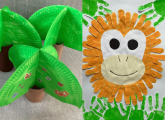Before phonics, we must focus on children’s vocabulary and talk, says Barbara Isaacs…
Montessori recognised the importance of language and communication in identifying them as one of the unique characteristics of all human beings.
The chapter on language in The Absorbent Mind provides insights into her thoughts about language acquisition.
She believed that we were born with a predisposition to language and communication; however, how this unique human trait develops depends on adults and how they support the child’s capacity to acquire language.
According to Montessori, babies need to hear everyday language spoken and absorb it into their unconscious memory, which she called Mneme.
We now know that babies in the womb can hear and absorb not only their mother’s and father’s voice but also music that is played in the home during the latter stages of pregnancy.
Close communications between the baby and mother or prime carer develop during feeding, and Montessori also advocates taking the child out so that they can absorb everyday language in the wider environment.
Singing and sharing of books from the first months of life contribute further to the child’s emerging capacity to express their needs and desires.
Montessori defines the advance of language as one of the key achievements of the young child and describes its progress in line with our present-day understanding of how a child’s language unfolds.
In addition, she urges adults to always use proper names for objects to increase vocabulary and maximise the opportunities for learning by associating an object with its name.
Therefore, she would always name a flower, tree or animal by its name rather than the generic term – daisies, dandelions and daffodils quickly become embedded in the child’s daily use of language.
We see the children’s capacity to remember the names in their naming of dinosaurs or more exotic creatures they encounter in books and on their ipads, such as pangolins, armadillos and tiger fish, all of which are part of the child’s life today.
This expanded vocabulary is also evident in children’s capacity to form sentences and to express their feelings and interests. How the child’s is spoken to is directly mirrored in his/her own capacity to communicate.
Children also pick up the nuances of our feelings as we communicate with them. They have an inborn need to communicate, and oral language should be supported and developed alongside awareness of the written word in books and daily life.
It is now generally agreed that oral language and verbal skills should precede the introduction of literacy. For Montessorians learning to read and write is the ultimate stage of sensitive periods for language.
This final step enables children to share ideas, thoughts, beliefs and the feelings of others in printed formats such as books and share their own ideas with others by writing them.
Practically, today this means that with the two- and three-year-olds in our settings, we should focus on developing oral language skills to the highest possible level, prior to introducing phonics through languages schemes such as sounds and letters or similar.
Montessori nurseries use language baskets/boxes with two-year-olds. They contain collections of four to six objects such as fruits/vegetables, farmyard/wild/sea animals, or emergency/transport vehicles.
These are named for the children as they explore them and then they have an opportunity to match them to photographs of these objects.
Later, the children can choose a basket or box and spontaneously name the objects as they match them to the pictures – in this way they are practising the names in association with the object.
Playing games like ‘Simon Says’ or ‘Odd Man Out’ further enhances the children’s use and awareness of words, and when ‘I Spy’ games are introduced with six to eight objects, young learners begin to gain familiarity with their initial sounds.
This playful focus on phonics provides some of the foundations to literacy for this age group.
Alongside this work, teachers will make sure of each child’s capacity to hear small differences in sounds by using matching sounds boxes from the sensorial area of the classroom.
They will also play the ‘silence game’, which invites the child to sit still for short periods of time and listen for their name as it is whispered.
This capacity to sit still is essential as the child is introduced to the multisensory sandpaper letters, which combine phonic sounds with shapes of the letters as the child traces them.
Finally, writing skills are developed by practising and refining fine motor skills, for example, when using utensils such as tongs, tweezers and scissors.
Flexibility of the wrist is enhanced during sand play using containers to pour sand, and hand-eye coordination grows whilst building with blocks and during gluing activities.
All these contribute to the child’s capacity to hold a pencil and begin to make marks on paper in a coordinated manner. With practice the child will get better, and usually the first word they will learn to write is their name.
Gradually they will combine their knowledge of phonics with writing skills and they will create their first stories and rhymes.
Barbara Isaacs is global Montessori ambassador for Montessori St Nicholas.

Nature crafts – Make your own rainforest
Editors picks

Pets in school – Does your setting need an animal?
Editors picks
